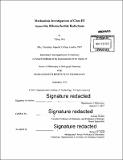Mechanistic investigations of class III anaerobic ribonucleotide reductases
Author(s)
Wei, Yifeng, Ph. D. Massachusetts Institute of Technology
DownloadFull printable version (19.82Mb)
Other Contributors
Massachusetts Institute of Technology. Department of Chemistry.
Terms of use
Metadata
Show full item recordAbstract
Ribonucleotide reductases (RNRs) catalyze nucleotide reduction via complex radical chemistry, providing deoxynucleotides for DNA synthesis in all domains of life. The focus of this thesis is the class III RNR, found in anaerobic bacteria and archaea, which uses an O₂-sensitive glycyl radical cofactor (G*). The class III RNRs studied to date couple nucleotide reduction to the oxidation of formate to CO₂. We started by studying the Escherichia coli class III RNR (NrdD1), and found that reaction with CTP (substrate) and ATP (effector) in the absence of formate leads to loss of G* concomitant with stoichiometric formation of a new radical species and a "trapped" cytidine derivative, proposed to be 3'-keto-deoxycytidine. Addition of formate results in the recovery of G* and reduction of the cytidine derivative to dCTP. The new radical was identified by 9.5 and 140 GHz EPR spectroscopy to be a cysteine-methionine thiosulfuranyl radical [RSSR2]*. Analogies with the disulfide anion radical proposed in the class I and II RNRs provide further evidence for the involvement of thiyl radicals in the reductive half reaction of all RNRs. A subsequent bioinformatics investigation led to the identification of a second subtype of class III RNR (NrdD2) with distinct active-site residues suggesting that, like the class I and 1I RNRs, reducing equivalents for nucleotide reduction are provided by a redoxin, which are ubiquitous proteins found in all organisms, instead of formate, a metabolite produced by some but not all organisms. The Neisseria bacilliformis NrdD2 was cloned and expressed, and found to catalyze nucleotide reduction using the thioredoxin / thioredoxin reductase / NADPH system. An activesite model based on a crystal structure of the homologous Thermotoga maritima enzyme showed conserved residues appropriately positioned to carry out chemistry. Phylogenetic studies suggest that NrdD2 is present in bacteria and archaea that carry out diverse types of anaerobic metabolism. The bioinformatics study also uncovered a third subtype of class III RNR (NrdD3) present in certain methanogenic archaea. The presence of a redoxin (NrdH) in the operon suggested redoxin-dependent chemistry like NrdD2. However, its distribution among the different types of methanogens suggested that reducing equivalents might come from reduced ferredoxin (Fdx) generated in methanogenesis, rather than from NADPH. The Methanosarcina barkeri class III RNR was cloned and expressed, and found to catalyze nucleotide reduction using a system involving Fdx, NrdH and a [4Fe4S] protein ferredoxin:thioredoxin reductase. The diversity of reducing equivalents used for anaerobic ribonucleotide reduction reflects the diversity of electron carriers used in anaerobic energy metabolism.
Description
Thesis: Ph. D. in Biological Chemistry, Massachusetts Institute of Technology, Department of Chemistry, 2015. Cataloged from PDF version of thesis. Includes bibliographical references.
Date issued
2015Department
Massachusetts Institute of Technology. Department of ChemistryPublisher
Massachusetts Institute of Technology
Keywords
Chemistry.